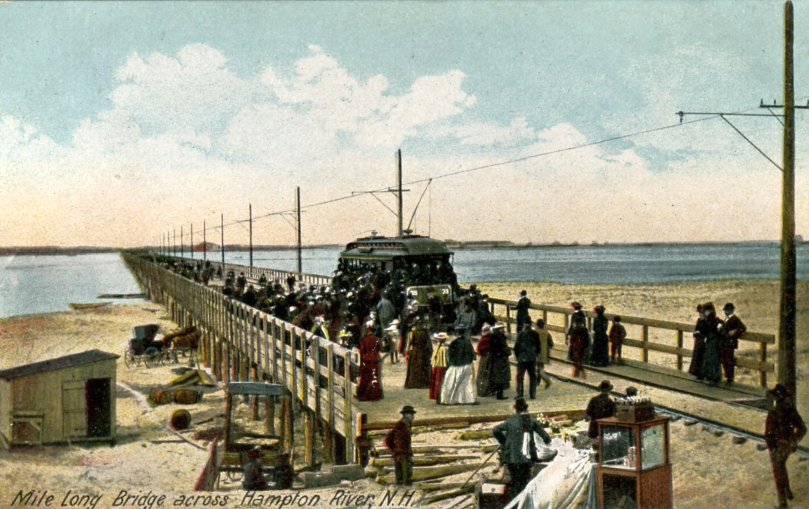Special to the Union
The Manchester Union, Manchester, N.H.
Wednesday, July 23, 1924
HAMPTON BEACH, July 22. — On the register of the Ocean House at this beach, the name of W. D. Cowles, Amherst, Mass., might be passed over by the casual observer with but little comment, for at first glance it carries nothing in particular but to those who are familiar with the history of Hampton Beach, it will recall the fact Mr. Cowles was the builder of the Mile Long bridge.
When this man first came to Hampton, the river by the same name flowed unhampered to the sea, its mouth a few hundred yards south of where it is today. And when he left, a great plank structure had been built, resting on more than four thousand piles and embedded at both the Hampton and Seabrook ends in sand. The bridge, had it been extended nearly 200 yards longer, would be approximately a mile in length.
The originator of the idea was Wallace D. Lovell who was building a chain of street railroads. It was designed by Ralph D. Hood of Haverhill, and of course, built by Mr. Cowles. Over $100,000 worth of lumber was used in the structure and B. T. Janvrin of Hampton [Falls] set up a portable sawmill in the village where the huge timbers were made. Nothing like it had ever been built before and many skeptical visitors came to watch the progress of the work, of the opinion sooner or later that the project would be halted with a large loss to the promoters.
At the time when the hearing was held in Concord in 1901 in regard to the application for a charter, prominent railroad men appeared in opposition and stated that engineers had been over the project and that it was absolutely impossible to construct a bridge over the river at this point and have it stand. But the work went on, and after a year of toil, it was formally opened for traffic on May 14, 1902. The charter was granted the Granite State Land company which acquired much land at Hampton and Seabrook beaches.
All the 4,000 piles were floated down the Hampton river, being cut from the nearby forests, while all the timber used in the construction of the bridge, which included more than a million feet of hard pine, was brought from the South in large steamers to the nearby cities, unloaded, made into rafts, and towed along the ocean front and then up the river to the bridge site.
When the structure was completed, there was a waterway under it of more than 40,000 feet. Today the shifting sands and tides which have been working with might and main, have reduced it to something like only 10,000 feet.
The dedicatory exercises were held in the middle of the bridge and were elaborate. The governor of New Hampshire, Chester B. Jordan, rode across the span in an official [trolley] car and the speeches were given from a raised platform in the middle of the bridge. Addresses were given by Henry M. Putney, chairman of the railroad commissioners of New Hampshire; N. J. Bachelder, master of the State Grange; John McLane of Milford and Dr. Charles S. Murkland, then president of the State college at Durham. More than two hundred enjoyed a banquet at Whittier’s hotel in Hampton, which has since burned, but at that time was a noted hostelry.
The first of Lovell’s line was built in 1897 from Exeter to Hampton Beach. The Casino was started in 1900, at a time when there were no other buildings in the vicinity and the car line terminus was between Cutler’s Sea View House and Great Boar’s Head. The Exeter line was continued to the bridge in 1901.
